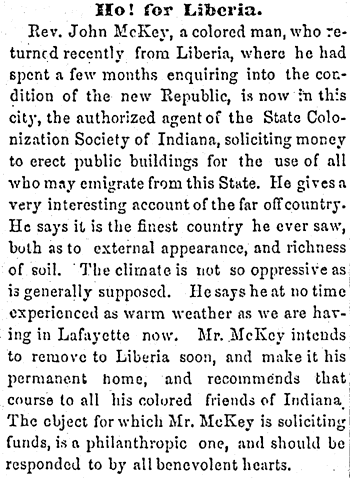Mary Anthrop Guest Editor
One afternoon about twelve years ago, as I was reading microfilm copies of newspapers in the Tippecanoe County Public Library, my attention wandered to a small local article. The 1854 notice announced the visit to Lafayette of John McKay, an African-American agent of the Indiana Colonization Society. Having recently returned from Liberia, he was traveling around the state recruiting emigrants and securing financial support from white benefactors. How interesting, I thought, and I copied the article.
Curiosity prompts long-term search.

Courtesy: Lafayette Daily Courier, July 7, 1854.
Several years later I was asked to prepare a program on African-American life in Tippecanoe County before the Civil War. When I remembered the clipping on John McKay's visit to Lafayette, I began a research journey that would take me from county and state depositories to the Library of Congress.
Researching African-American history and the colonization movement in Indiana has been challenging as well as fascinating. Indiana references to colonization relied almost solely on Indiana governmental records, and did not reveal the emigrants' personal stories. So I turned to county secondary and primary resources.
Unfortunately secondary county histories often do not discuss minority experiences prior to the Civil War. At first, some of the fragmented glimpses of African-American life in primary sources appeared insignificant. I discovered, however, that these collected bits of primary information presented the key to understanding nineteenth-century African-American life.
Contemporary newspapers and periodicals occasionally made references to African Americans and their activities. Newspapers noted church and social gatherings. African-American barbers described their businesses in newspaper ads. Local white commentary on African-American activities, however, often reflected a biased viewpoint. Newspaper articles rarely quoted African Americans.
Legal documents, such as marriage records, court records, and deeds, helped to answer questions about family life, religious practices, legal disputes, and land ownership among African Americans.
Census records of 1850 listed heads of household, family members, occupations, and personal wealth. A few historical depositories held business account books, which described African-American economic exchanges.
Locating original writings of African Americans was another difficult task. The Indiana Colonization Society agents frequently quoted excerpts of emigrant letters in their reports or reprinted them in local newspapers. Some historians, however, question the authenticity of such letters. Opponents of colonization had often charged that agents had edited emigrant letters. Original copies of the letters which would prove the authenticity of the printed versions have almost all disappeared.
The American Colonization Society Collection at the Library of Congress provides an invaluable source of primary materials; it contains letters from Indiana emigrants. Microfilm of the records is available through interlibrary loan.
I began my research journey with a single newspaper clipping. Now I have an overflowing archival box of file folders. I do not, however, consider the journey complete. On the research trail, I explored only one experience of Hoosier African Americans. Now I hope to begin a writing and sharing journey, and I encourage young historians to take on similar challenging trips.
